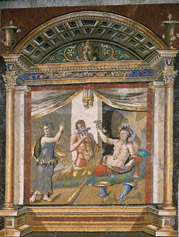COMMITTEE FOR THE EXCAVATION OF ANTIOCH-ON-THE-ORONTES
In 1928, Charles Rufus Morey, chair of Princeton's Department of Art and
Archaeology, proposed the exploration and excavation of the ancient and medieval
site of Antioch, located in northern Syria near the Turkish border. Founded
in 300 B.C., Antioch was one of the most important political and cultural
centers of the Hellenistic East and one of the great metropolises of the Roman
Empire. Morey wrote, “To continue the work of Howard Crosby Butler in
the archaeological exploration of Syria has of course always been a desire
of this Department at Princeton.”
Morey’s involvement began as early as 1927, when the French Antiquities
Service asked if Princeton would be interested in excavating at Antioch. Morey
replied, “We have had this project as a dream for some years.”
He thought that Princeton was the logical choice to direct the excavation
of Antioch because the project would be a natural extension of Howard Crosby
Butler’s expeditions to Syria, and because the Index of Christian Art,
which he had founded in 1917, was the institution best equipped to interpret
the Early Christian and Byzantine materials that would certainly be found
at Antioch.
The opportunity to excavate came in 1930, when the Syrian Antiquities Service
finalized the concession and Princeton was granted the right of excavation
for a six-year term, beginning January 1, 1931. Fund raising, including the
search for additional subscribers and sponsors, continued throughout 1931.
In December of 1931, the Committee for the Excavation of Antioch-on-the-Orontes
was formed; its members included the Worcester Art Museum, the Baltimore Museum
of Art, the Musées Nationaux de France, and, of course, Princeton,
which assumed direction of the expedition and responsibility for the publication
of its results.
Fieldwork began on March 4, 1932, under the general direction of George W.
Elderkin, Princeton professor of art and archaeology. The staff consisted
of Clarence Fisher of the American School of Oriental Research in Jerusalem
as field director, William A. Campbell of Wellesley College as assistant field
director, and Jean Lassus of the French Institute at Damascus.
 Four campaigns were carried out at Antioch and its suburb Daphne between 1933
and 1936. When the original concession expired in July of 1936, the Committee
for the Excavation of Antioch asked for a renewal of the concession for the
maximum period of six years. The Department of Syrian Antiquities granted
this request, and the subscribing institutions extended their support, thereby
ensuring the continuation of the excavations. The renewal also granted the
right to excavate the port city of Seleucia, where preliminary work began
within the city walls in 1937.
Four campaigns were carried out at Antioch and its suburb Daphne between 1933
and 1936. When the original concession expired in July of 1936, the Committee
for the Excavation of Antioch asked for a renewal of the concession for the
maximum period of six years. The Department of Syrian Antiquities granted
this request, and the subscribing institutions extended their support, thereby
ensuring the continuation of the excavations. The renewal also granted the
right to excavate the port city of Seleucia, where preliminary work began
within the city walls in 1937.
The final excavations of the campaign took place in September of 1939. The
prevailing sentiment was that time was running out. The earlier sponsors of
the dig, still suffering the effects of the Depression, were hesitant to fund
excavations. In Europe and in the Middle East war was looming. The most immediate
crisis was the secession of Hatay province, where Antioch was located, from
Syria to Turkey, a country with strict laws governing the exporting of antiquities.
Consequently, the field director William Campbell had a rather difficult time
extracting the committee’s share of excavated objects, as stipulated
in the original concessions negotiated with the Syrian Department of Antiquities.
Ultimately the 300
mosaics and all the other finds were divided on a share basis among the various
subscribers, including the Turkish government. Work was finally suspended
with the outbreak of World War II.